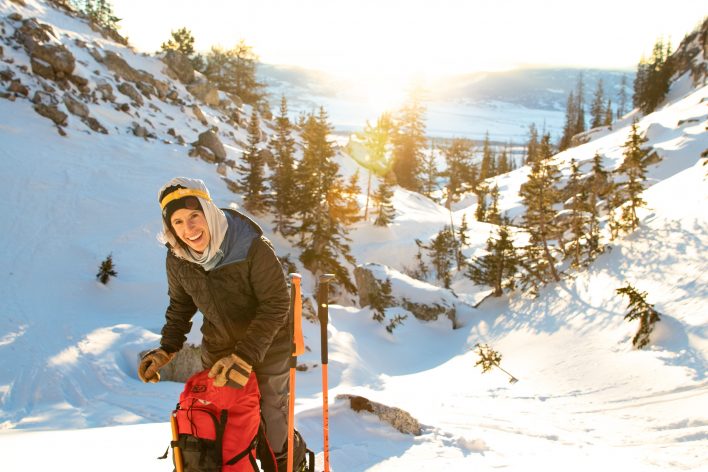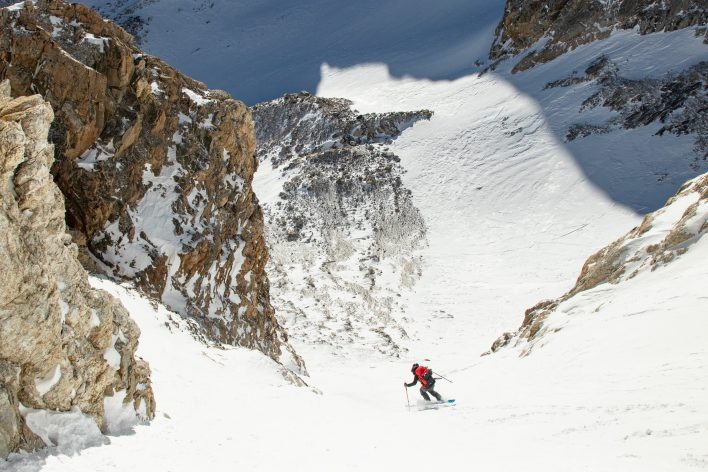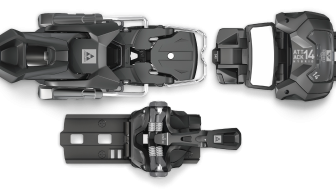I often appreciate that my truck doesn’t have a temperature gauge—it allows me to pretend it’s not quite so cold on early morning starts. But on this particular morning, there was no pretending. Temperatures were well below freezing.
For the past few weeks, a long-lasting high-pressure system had settled over Jackson, making good snow hard to find.
The air bit at our cheeks and frost grew on our hair as my ski partner Joey Sackett and I skinned through the darkness. We were heading to ski the East Face of the Middle Teton.
Two hours and 2,500 feet of elevation gain later, we crested into the heart of Garnet Canyon. The Middle Teton greeted us; the summit, towering 3,500’ above us, glowed in soft red light. We were making good time and the rising sun’s rays felt restorative.

[Photo] Joey Sackett
As the skintrack climbed, it became increasingly firm and slippery. The wind had picked up over the past few days. While it was currently calm, waves in the snow spoke to the strong breaths blown overnight.
In preparation for less-than-ideal conditions, we carried crampons and ice axes, along with other ski mountaineering gear. Even in good weather, the East Face is one of the more daunting lines in the region, demanding proper preparation and equipment. Steep and exposed, I was eager to ski the line I’d heard many of my friends talk about.
As we were about to round the Middle Teton’s shoulder and reach our approach couloir, I paused. In my head, a doubtful voice asked, “Are these really the right conditions to try this consequential line in?” Despite the allure of a big objective, I couldn’t ignore that something didn’t feel right.
In the backcountry, an obvious yes or no is easy, but this was uncertainty at its finest. The only way to gather more information about the snow quality on the east-facing line was to fully commit to trying for the top. But the next big step of our ascent required climbing the opposing Southwest Couloir to reach the summit, then dropping down the mountain’s other side onto the East Face. Conditions in the couloir would be slippery with loose rocks—terrain that is much easier to go up than down. If we summited and didn’t like the conditions on the East Face, it would be a slow, tedious retreat back down the couloir we had just climbed.
For the East Face, we packed a rope and rappel gear as an extra margin of safety to descend the extra-steep summit block. Lower down on the face, we wouldn’t have any established anchors for a ski belay on the steep, exposed lower section — there was no bail option. And we wouldn’t be able to gather information about the snow quality on the East Face until we were on it. We had to decide whether to continue or turn back, before going further.

I’ve found that learning to dig deeper and make these decisions takes as much practice and purpose as my technical ski mountaineering skills. Taking a step back, Joey and I reframed the question from “We probably could, but should we?” to “How do I want to do it?” which invited a greater depth of discussion. We realized we wanted to enjoy the experience—not just grimace through to say that we had done it. We wanted to find joy in a line that pushed us, not just to check a box. While the East Face was our objective, our underlying goal was simply to get up high and have a long day in the mountains with significant elevation gain to train for further spring expeditions. Plus, we acknowledged that because we lived in Jackson, Wyoming, only a short distance away, we would have more opportunities to attempt the route in better conditions.
Our discussion led us to decide that while the summit block was slightly too high of a risk for that day, the lower part of the route — less steep and more wind-protected — was safe enough to attempt. Perched underneath Ellingwood Couloir, we looked up toward a potential alternate route, realizing we could bypass the additional hazards of the true summit and still access the rest of our initial line in a less consequential zone. And, the Ellingwood was filled with snow, rather than loose rock, making it easier to simply descend the way we came, if needed. With 1500 feet of vertical gain and sections as steep as 50 degrees — making it one of the steepest couloirs in the Tetons — it offered an adventurous Plan B with less uncertainty than our original route…or so we thought.
Scoping the couloir from the bottom, we could see a tight choke. As we hiked toward the feature, unsure of our ability to pass through, the firm snow began to soften in the sun. Our crampons cut in perfectly without punching too deep. Then, near the choke the snow thinned, becoming increasingly faceted—crumbling sugar-like underfoot. With a small ice bulge blocking our passage through the rocks, we stopped to assess our next move.

[Photo] Joey Sackett
“I think we’ll have to make two real ice climbing moves to get over the bulge,” Joey said—doable but sketchy.
Having packed for a different route, we each only had a single ice axe. Once again, we were at a decision point. Openly, we discussed how having bailed earlier in the day made us feel slightly more eager to go for the new plan. Though eager to challenge ourselves, we laughed lightheartedly about once again being stuck on “we probably could, but should we?”
Returning to our goal of getting a long day in the mountains, we reframed some of the disappointment with humor, joking about the extra elevation we gained only to bail again. And that’s just what we did—we bailed, popped on our ski gear and ripped the 800 feet we had just climbed.
Knowing our home range well, we decided to take one last run, this time opting for a chill line we knew was well within our safety margins—even in variable conditions. One last time, we transitioned to uphill mode, then headed up a different fork of the canyon. The snow was better than expected, though nothing stellar. We skied for a few thousand feet and safely made our way back to the parking lot. At the end of it all, we had a meandering 10-hour day with 7000 feet of elevation gain, a route full of beautiful views and lackluster snow. It was less exciting than getting to ski a dream line but ended up serving as good training not just physically but mentally, too.
For more advice and anecdotes on the art of bailing, or “Failing Upwards,” pick up a copy of Issue #150, The Skills Guide at backcountrymagazine.com/150 or subscribe.










It is what it is. If conditions would have been great, nothing would have stopped you from going all the way. Trust your gut. If it doesn’t look good, bail and do it another day when the conditions are better.
” Plus, we acknowledged that because we lived in Jackson, Wyoming, only a short distance away, we would have more opportunities to attempt the route in better conditions.”
This is a real consideration for everyone, and at the same time, completely irrelevant to the objective risk. So hard to put that aside…if you had come 1000 miles to do this, would it be a better idea to do it? No. Still, you might decide to take more risk. Is that wise? Who can say, a personal/group judgement.
What I appreciate is that you discussed and considered all these factors, so you’re making a conscious and group decision, balancing the emotional and rational factors.